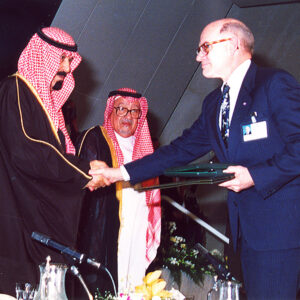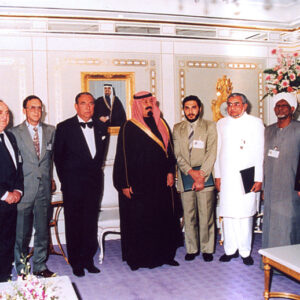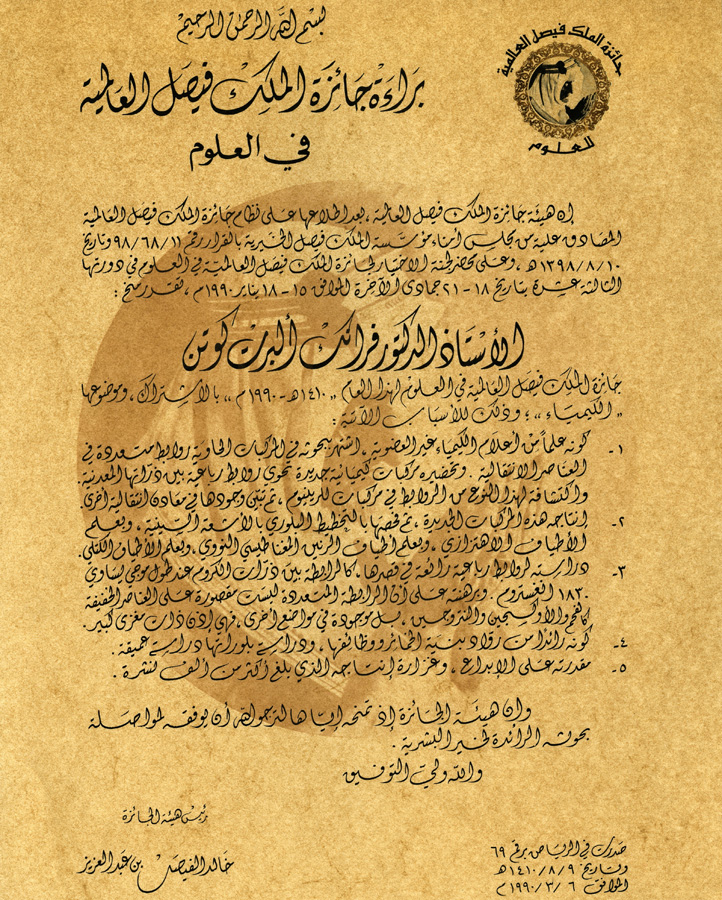

Professor Frank A. Cotton
King Faisal Prize in Science 1990 Laureate
Topic: "Chemistry "
It is necessary that humanity pay great attention to our cultural, moral, and artistic life, so that we can maintain our human values as we wish them to be

Frank Albert Cotton received his BA in Chemistry from Temple University in 1951 and a Ph.D. from Harvard University in 1955. He began teaching at Massachusetts Institute of Technology (MIT) in 1955 and became full professor within merely six years. In 1972, he moved to Texas A&M University as the Robert A. Welch Professor of Chemistry and was later appointed as a Doherty-Welsh Distinguished Professor of Chemistry in 1984. He was also the Director of the Laboratory for Molecular Structure and Bonding at Texas A&M.
Professor Cotton was one of the world’s pre-eminent chemists. Both the quantity and the significance of his research were prodigious. He demonstrated an exceptional mastery of preparative chemistry, particularly in the fields of inorganic and organometallic chemistry. He discovered many new classes of compounds and the methods for preparing them. He also made seminal research on metal metal bonds, particularly quadruple and other multiple bonds; his work in this field is asserted to have “transformed our understanding of how the chemistry of about half the periodic table really works.” Cotton’s research resulted in more than 1000 scientific articles, authorship of many popular books that were translated into several other languages and the training of 80 Ph.D. students and 120 postdoctoral associates. Two of his books, Advanced Inorganic Chemistry and Chemical Applications of Group Theory, became some of the most widely used books in the field. The former book, which was co-authored with Sir Goeffrey Wilkinson, was first published in 1961 and is now in its 6th edition (with two additional co-authors); it incorporates more than 4000 references to literature and is considered like a bible of inorganic chemistry. The second book, first published in 1963, did the magic of introducing generations of chemists to group theory and its applications in the analysis of bonding and spectroscopy. Professor Cotton also founded the important annual series Progress in Inorganic Chemistry and edited its first 10 volumes. He also chronicled metal-metal bonding in his book, Multiple Bonds Between Metal Atoms (jointly with R. A. Watson).
Professor Cotton was honored with many prestigious medals, awards, honorary doctorate degrees, fellowships and editorships. Among his most distinguished awards was the United States’ highest scientific award, the National Medal of Science.
Professor Cotton was a world leader in the area of organometallic chemistry, metal carbonyl chemistry and metal atom cluster species. Through his pioneering work on multiple bonds between metal atoms, he has opened a new chapter in inorganic chemistry.
He had also been one of the most prolific contributors to scientific literature with over 1000 publications and several textbooks to his name.
This biography was written in the year the prize was awarded.
- He received many awards and honors including:
- Robert A. Welch Prize in 1994.
- Wolf Prize in 2000.
- Lavoisier Medal of the French Chemical Society in 2000.
- Professor Frank Cotton passed away in College Station, Texas on 20/2/2007.



